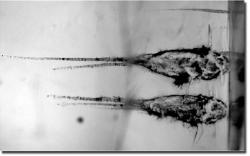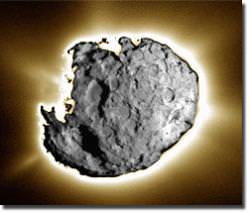Just so it’s clear in your mind: comets are dirty snowballs, asteroids are rocks. Got the difference? Wait… not so fast. Scientists studying the cometary dust picked up by NASA’s Stardust spacecraft, and they’re finding it’s surprisingly asteroid like.
When Stardust flew past comet Wild 2 in 2006, scientists knew they would be scooping up materials created with the very formation of the solar system. But they didn’t think the dust from Wild 2 would resemble meteorites more than ancient, unaltered comet.
Comets are thought to contain large amounts of primitive material in the Solar System. Both the ancient ices that formed out of the stellar disk, but also the rain of interstellar material falling into the Solar System.
According to researchers at Lawrence Livermore National Laboratory, the particles that fell off Wild 2 formed very close to the Sun when it was young. They had been baked and blasted by the intense ultraviolet radiation of a newly forming star. Furthermore, they didn’t find the kind of primordial materials and ices that should have been present on an ancient comet like Wild 2.

“The material is a lot less primitive and more altered than materials we have gathered through high altitude capture in our own stratosphere from a variety of comets,” said LLNL’s Hope Ishii, lead author of the research that appears in the Jan. 25 edition of the journal, Science. “As a whole, the samples look more asteroidal than cometary.”
But Wild 2 is clearly a comet and not an asteroid. It’s got a tail; what could be more cometlike? It’s a reminder that there isn’t a clearly defined line between the two objects – there’s a continuum between them.
The researchers were expecting to see very specific minerals in the Stardust samples that should be coming from comets: glass with embedded metal and sulfides, and sliver-like whiskers of the crystallin silicate enstatite. They found only a single sample of enstatite in their samples and it was oriented the wrong way.
There were similar minerals found, but the researchers realized that they were being created when particles from the comet slammed into the Stardust collector. They were able to recreate this process in the lab.
For future studies, the researchers are hoping to get their hands on larger-grained materials, called micro-rocks. These would suffer less alteration from the impact with the Stardust collectors.
Original Source: LLNL News Release


Fascinating. We need more missions like Stardust to learn exactly what is the nature of comets and asteroids so that we have a clearer picture of how our solar system (and all of the other solar systems) formed.
We should have a Cassini type orbiter around every planet in the solar system.
Then we’d never get away from the computer.
I’d like to see a Stardust-like mission (fly through & sample return) sent to Enceladus.
stargazerdude – Enceladus is a good idea – but it’s a loooong way off. It’d be tough.
I agree that Enceladus is a good idea. While we won’t be capturing any samples, Cassini is scheduled to perform a low-level orbital pass through the ice geysers in the near future, which should provide us with at least some data about the composition of the clouds as well as the mechanism that causes them.
Marcellus – you got that right…I cannot even begin to count the hours I have spent looking at images, data, etc. from the recent Cassini and Galileo orbiters to Saturn and Jupiter.
I look forward to data from the New Horizions mission to Pluto and Messenger’s data from Mercury soon, too – its great to see up-close hi-res images of what appear as little dots, smudges, and dark spots when I view through my telescopes.